Intel Core i5-14400 vs AMD Ryzen 5 7600X Faceoff: AMD Delivers a Value Beatdown
Raptor Lake Refresh vs Zen 4, Fight!

At first glance, the Intel Core i5-14400 versus the AMD Ryzen 5 7600X seems to be a bit of a mismatch. Going by MSRP pricing, the Ryzen 5 7600X is nearly $100 more expensive than the Intel CPU, which is a substantial difference in this price band. However, recent price cuts to the AMD Ryzen 5 7600X have brought it closer to the Intel Core i5-14400's price point, making this a heated duel for mid-range CPUs.
At $225, The Core i5-14400 is one of the more affordable offerings in Intel’s Raptor Lake Refresh lineup of 14th-generation desktop CPUs. It slots in just beneath the Core i5-14600K, which seems to be the logical competitor to the AMD Ryzen 5 7600X based on MSRP pricing. However, don’t underestimate the Core i5-14400, as our in-depth review shows that it is still a compelling CPU for gamers on a modest budget.
Its competitor, the AMD Ryzen 5 7600X, is AMD’s entry-level CPU for the Ryzen 7000 series based on the new Zen 4 architecture. Initially priced at $299, AMD had set a very steep bar for entry into its new AM5 lineup as it seems to have abolished the entry-level Zen 4 Ryzen 3 SKUs, at least for now. Nonetheless, the Ryzen 5 7600X has seen recent price cuts and is now priced at a very reasonable $210, spelling danger for the Core i5-14400.
The comparison between these two CPUs is not restricted only to their head-to-head performance, even though that is a big part of our face-off. AMD has taken the leap to a completely new AM5 platform, which requires DDR5 memory, so the ecosystem around the Ryzen 5 7600X remains more expensive even though the discounted chip helps offset the pricing challenges.
On the other hand, the Intel Core i5-14400 is a refinement of the existing Raptor Lake i5-13400, which, in turn, was an incremental upgrade over the Alder Lake Core i5-12400. This means that Intel has an established motherboard ecosystem and support for both DDR4 and DDR5 memory, which may tip the scales back in favor of the Core i5-14400 in terms of value.
Let’s put these two CPUs through our six-round gauntlet covering gaming, productivity performance, pricing, and more to see how they stack up.
Features and Specifications: Intel Core i5-14400 vs AMD Ryzen 5 7600X
The Intel Core i5-14400 has ten cores and 16 threads, six of which are performance-oriented P-Cores, while the other four E-Cores are meant for background and heavily threaded tasks. The P-Cores can boost up to 4.7 GHz, while the E-Core boost clock is 3.5 GHz. The Core i5-14400 features 20MB of L2 cache and 9.5MB of L3 cache, a respectable distribution. The chip comes with 65W PBP (base power) and 148W MTP (peak) power ratings.
Get Tom's Hardware's best news and in-depth reviews, straight to your inbox.
Intel uses its “Intel 7” process node for all the Raptor Lake Refresh chips, including the Core i5-14400. This CPU is a refresh of the Core i5-13400 from the previous generation of Raptor Lake CPUs. The Core i5-14400 has a surprisingly respectable feature set, as it supports up to 192GB of memory with maximum speeds of DDR5-4800 and DDR4-3200. The chip also supports PCIe 5.0 and has decent connectivity options such as USB 3.2 support with up to 20 Gbps transfer rates.
The Core i5-14400 also comes with a bundled Laminar RM1 cooler, which is serviceable for day-to-day operation provided you have good case airflow and are not too worried about its noise levels. A cheap air tower cooler will help address any thermal or noise issues. The standard Core i5-14400 chip also offers the 24-EU integrated UHD Graphics 730 Engine, but you can also opt for the Core i5-14400F for a $15 saving if you don’t really need integrated graphics.
Of course, not being a K-series SKU, the Core i5-14400 does not allow CPU overclocking. However, Intel does allow memory overclocking on supported chipsets such as Z790, B760, and H770 motherboards. With this class of chip, however, the B-series and H-series motherboards from the 600 and 700 series make more sense.
In the Red corner, the AMD Ryzen 5 7600X is a mid-range offering from AMD based on the Zen 4 architecture. Built on the N5 TSMC 5nm process, the Ryzen 5 7600X features six performance cores and 12 threads in a more traditional layout, with no efficiency cores to speak of. Perhaps that is for the better since all six of Ryzen’s cores can be considered P-Cores, reflected in their boost clock of 5.3 GHz with a base clock of 4.7 GHz.
AMD has equipped the Ryzen 5 7600X with 6MB of L2 Cache, double that of its predecessor, and 32MB of L3 Cache. The TDP rating is 125W, while the peak power draw is 181W, which is quite high for a Ryzen 5 part. Moreover, AMD doesn’t include a stock cooler with the Ryzen 5 7600X and instead recommends a mid-frame tower cooler for this CPU.
The Ryzen 5 7600X does include a Radeon RDNA 2 iGPU for display output, a nice bonus over the previous generation. Of course, the AMD AM5 platform exclusively supports DDR5 memory, with the Ryzen 5 7600X being officially rated for DDR5-5200 speeds. Note that DDR5-5200 is only possible with 1 DIMM per channel, and the support drops to DDR5-3600 for 2 DIMMs per channel. AMD also supports ECC memory with the Ryzen 7000 series CPUs.
Moreover, PCIe 5.0 is a highlighting feature of the new AM5 platform, and up to 24 lanes of PCIe 5.0 can be made available to the user with AM5 motherboards. The Ryzen 5 7600X is also overclockable with both B650/E and X670/E motherboards, although the B-series chipset makes a lot of sense for this CPU from a value perspective.
✅ Winner: AMD
Although the Intel option has a slight advantage in chip pricing and supports more affordable DDR4 memory and motherboards, it falls behind the AMD Ryzen 5 7600X when you compare the numbers side by side. The Ryzen 5 7600X is overclockable, and although CPU overclocking is not what it used to be, it is still a major advantage over its Intel counterpart.
Moreover, the Ryzen boasts higher boost clocks and more cache, while Intel has more cores. AMD strikes back again with faster DDR5 speeds, but Intel also makes a strong case with its bundled stock cooler. However, the AMD AM5 platform will support more generations of CPUs in the future, which isn’t the case for the Intel platform.
While it is certainly close, the AMD Ryzen 5 7600t edges out the Core i5-14400 in terms of specifications and features.
Gaming Benchmarks and Performance: Intel Core i5-14400 vs AMD Ryzen 5 7600X
This article provides an overview of the performance metrics in our in-depth Core i5-14400 review. Below are the geometric mean of our gaming tests with the Core i5-14400 and the AMD Ryzen 5 7600X at 1080p and 1440p, along with more detailed breakouts.
The 1080p resolution results emphasize CPU performance more, and the differences tend to shrink with higher resolutions. We tested with an NVIDIA GeForce RTX 4090 graphics card to minimize the bottlenecks as much as possible. Since the Core i5-14400 supports DDR4 and DDR5 memory, we tested it with both configurations to highlight the best- and worst-case scenarios.
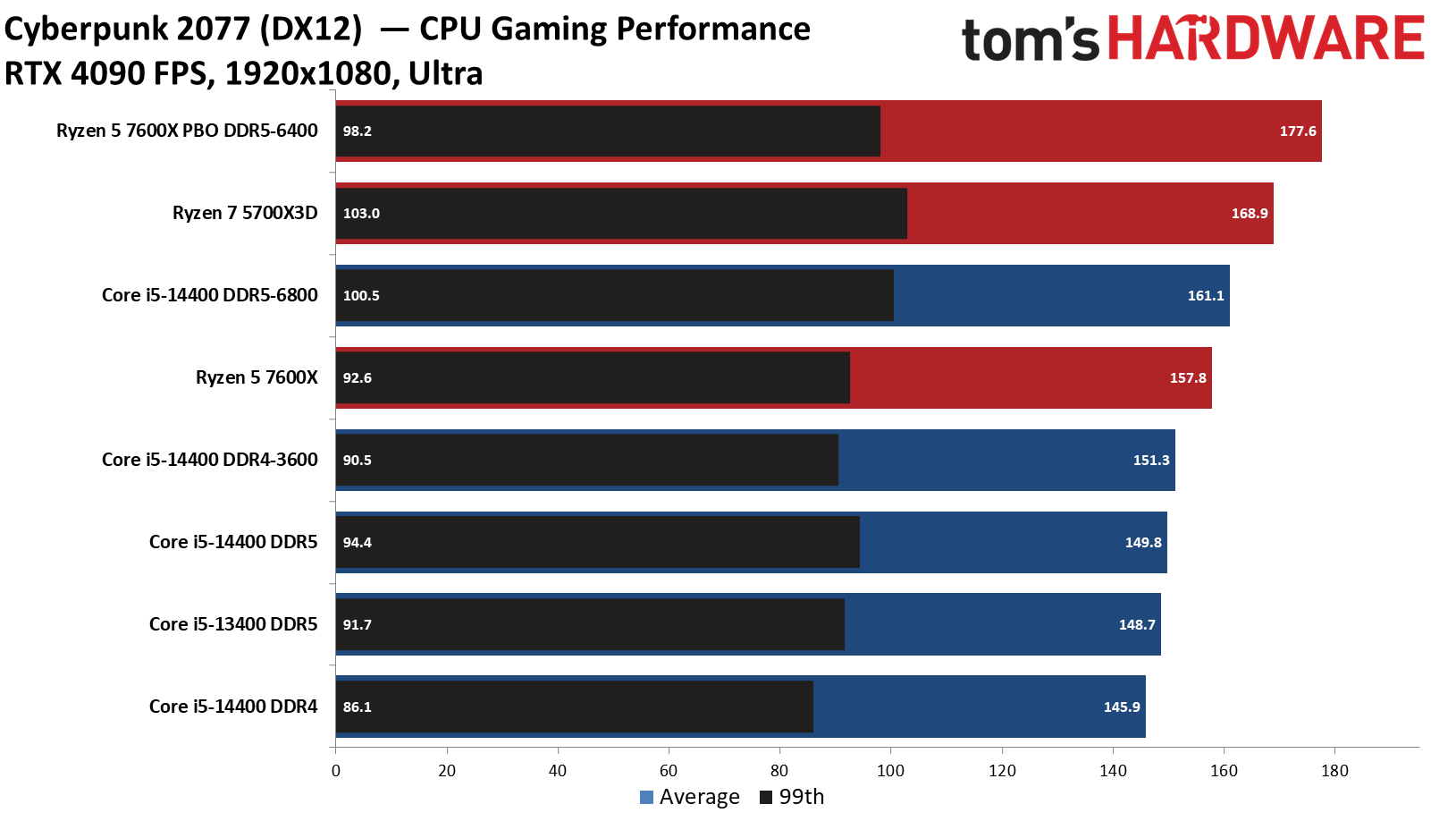
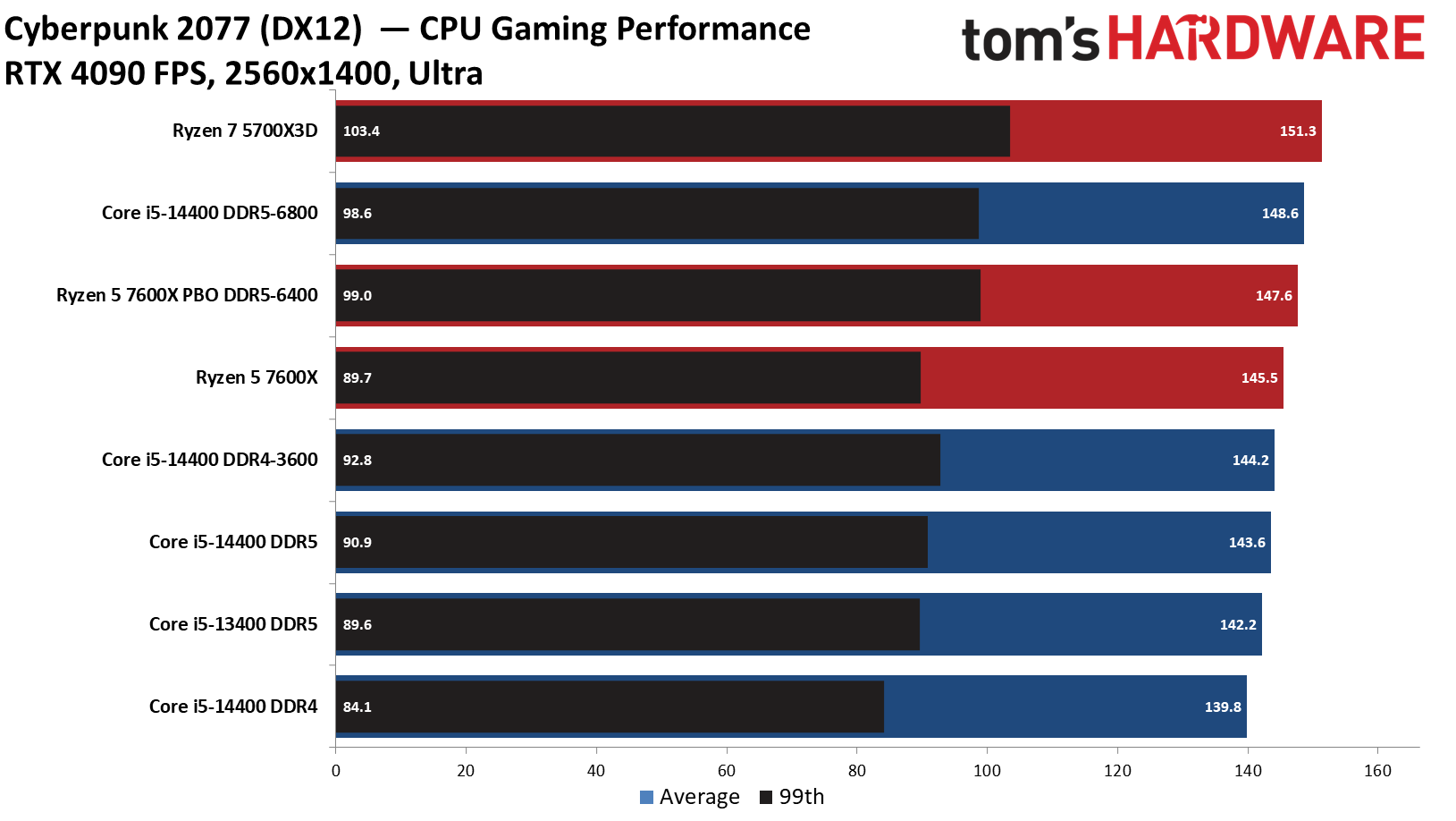









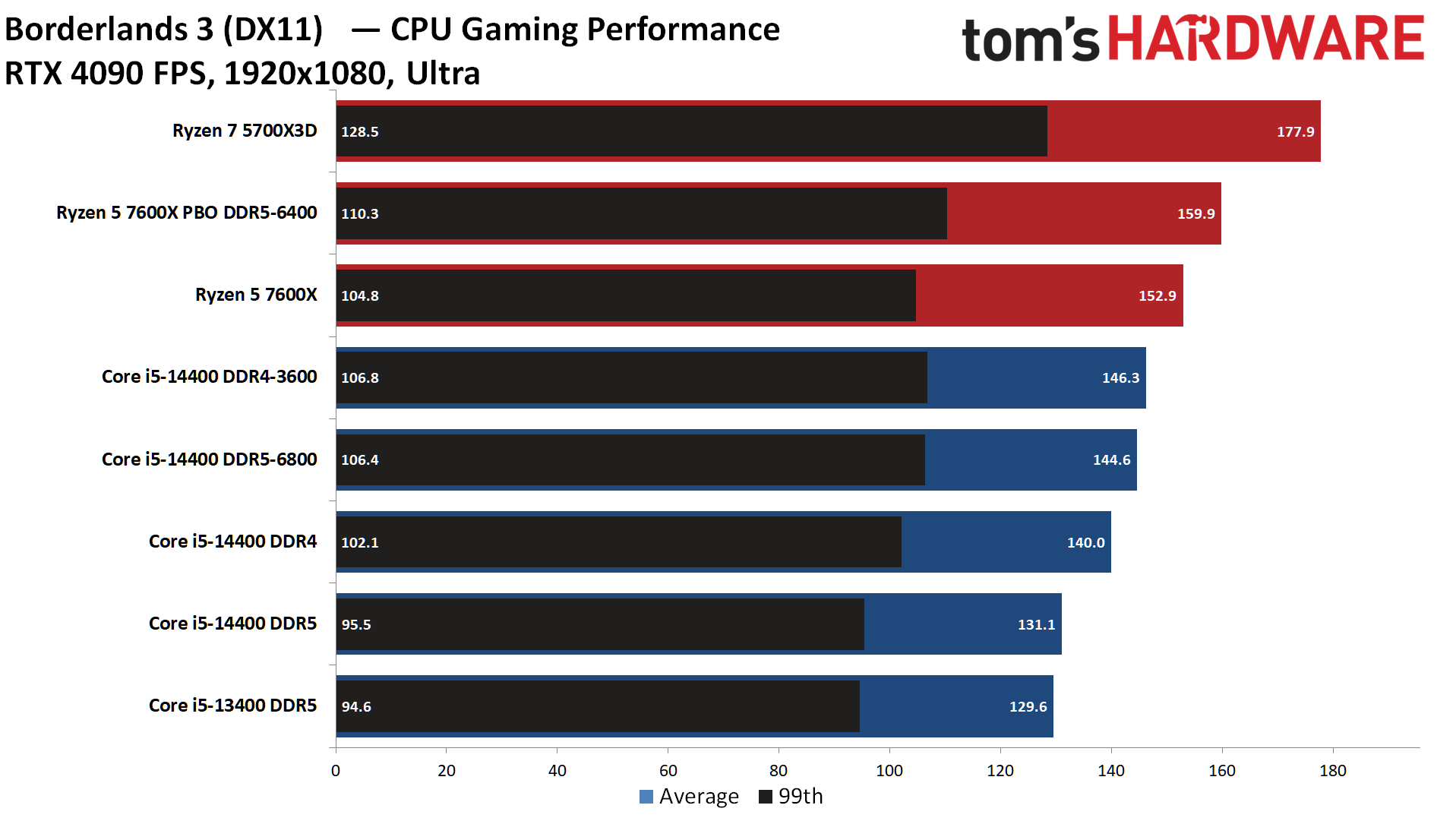

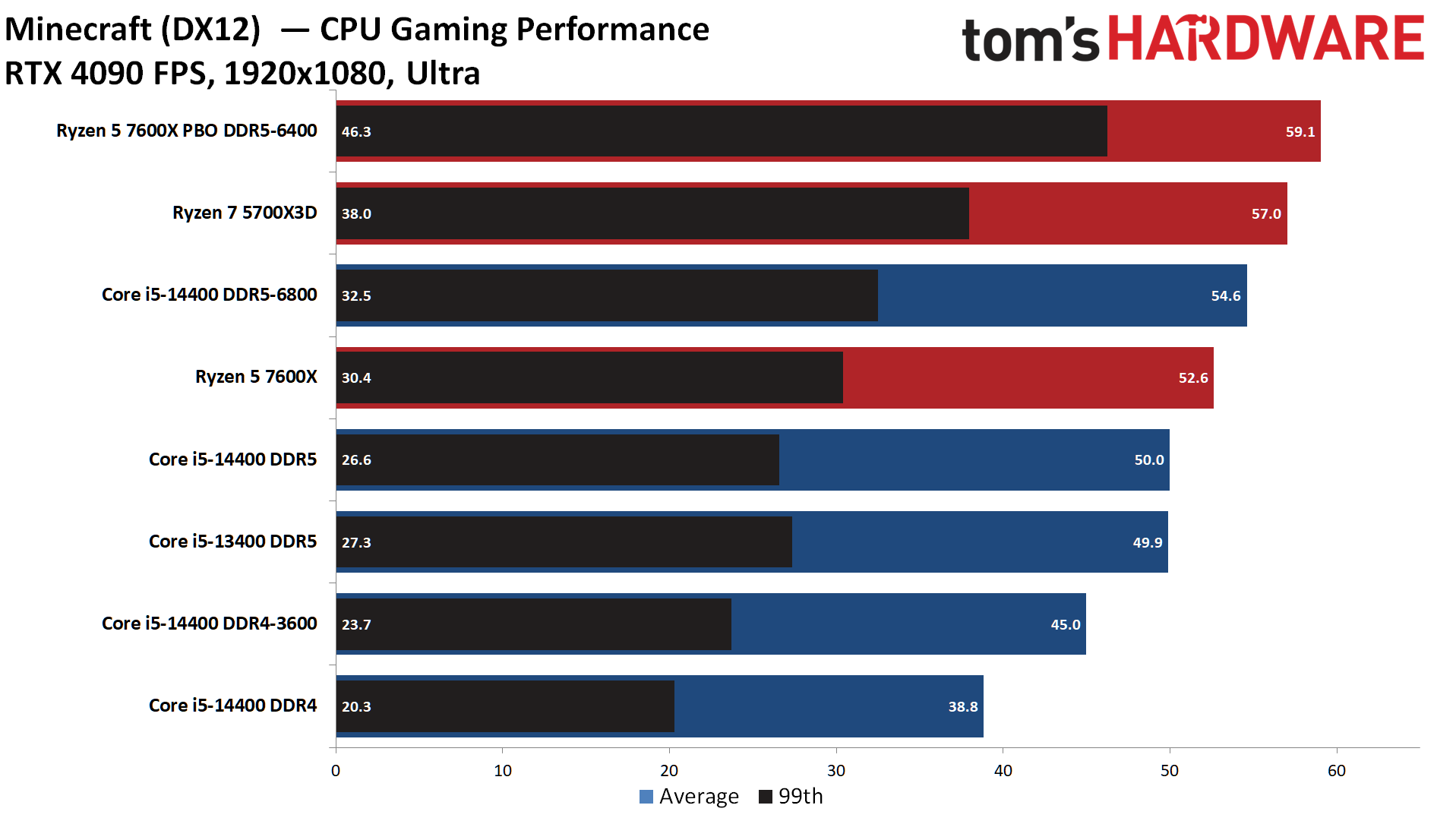




At 1080p, the AMD Ryzen 5 7600X and the Core i5-14400 offer virtually the same result in our average fps graph when the Core i5 is equipped with pricey DDR5-6800 memory. However, the performance delta increases noticeably when we switch to DDR4-3600 memory, with the Core i5-14400 being around 8.4% slower than the Ryzen 5 7600X.
The Core i5-14400 drops even more if you use standard DDR5 and DDR4 memory instead of the most optimized configuration. Once you turn on Precision Boost Overdrive (PBO) and pair the Ryzen 5 7600X with some fast DDR5-6400 memory, the performance delta increases even more, with the Ryzen 5 7600X gaining a substantial 7.8% lead over the fastest Core i5-14400 configuration. Safe to say that the Ryzen 5 7600X has a strong lead over the Core i5-14400 in 1080p gaming.
The hierarchy remains pretty much the same in our 99th percentile results at 1080p, with the Ryzen 5 7600X providing by far the most consistent framerates in our test suite. The Core i5-14400 with DDR5 memory does fall slightly behind the same CPU with DDR4 memory in this test, but that is within the margin of error. Here, you can also see the dominance of the AMD Ryzen 7 5700X3D in gaming applications, thanks to its unique 3D V-Cache design.
Moving on to 1440p results, we start to see the games get a bit more GPU-bound as the various CPUs start to group together in our results. Nevertheless, we still have a clear winner in the AMD Ryzen 5 7600X, as it holds a 6.5% lead over the Core i5-14400, even when the latter is paired with fast DDR5-6800 memory. The performance gap only grows when PBO is enabled, as the Ryzen can stretch the lead to a significant 11.3% over the fastest Core i5-14400 configuration.
If we just take the two CPUs in their stock state and pair them with standard DDR5 memory, the AMD Ryzen 5 7600X holds a 15.9% lead at 1440p and a 14.6% lead at 1080p. The performance delta remains pretty much the same when optimal DDR5 speeds are paired with both CPUs.
One interesting thing to note about the Core i5-14400 is its performance in relation to its predecessor, the Core i5-13400. As we can see in our test results, the two CPUs are almost neck and neck in our Average FPS tests at 1080p and 1440p and our 99th percentile tests. This really highlights the lack of tangible performance improvement in the Raptor Lake Refresh CPU over its predecessor, which is a big letdown.
✅ Winner: AMD
The Core i5-14400 really does not stand a chance against the Ryzen 5 7600X in this round. The AMD CPU dominates the Intel chip in all gaming benchmarks at 1080p and 1440p resolutions, even when the latter is paired with fast DDR5 memory. This is bad news for the Intel CPU, as recent Ryzen 5 7600X price cuts have actually made it cheaper than the Core i5-14400, significantly improving its performance per dollar.
It is also interesting to note that the Core i5-14400 does not offer a significant performance uplift over its predecessor, the Core i5-13400. Moreover, we also got some interesting results with the Ryzen 5 7600X, which beat the more expensive AMD Ryzen 7 5700X3D in some games when PBO was turned on. This showcases the immense gaming prowess of the Ryzen 5 7600X at its reasonable price point.
Productivity Performance: Intel Core i5-14400 vs AMD Ryzen 5 7600X
Productivity performance can be broadly divided into two categories: single-threaded and multi-threaded performance. Productivity applications generally lean towards a multi-threaded division of workloads, but that is not always the case. In our graphs, you can see the geometric mean of performance in our productivity test suite which includes several of the most important productivity applications currently available.






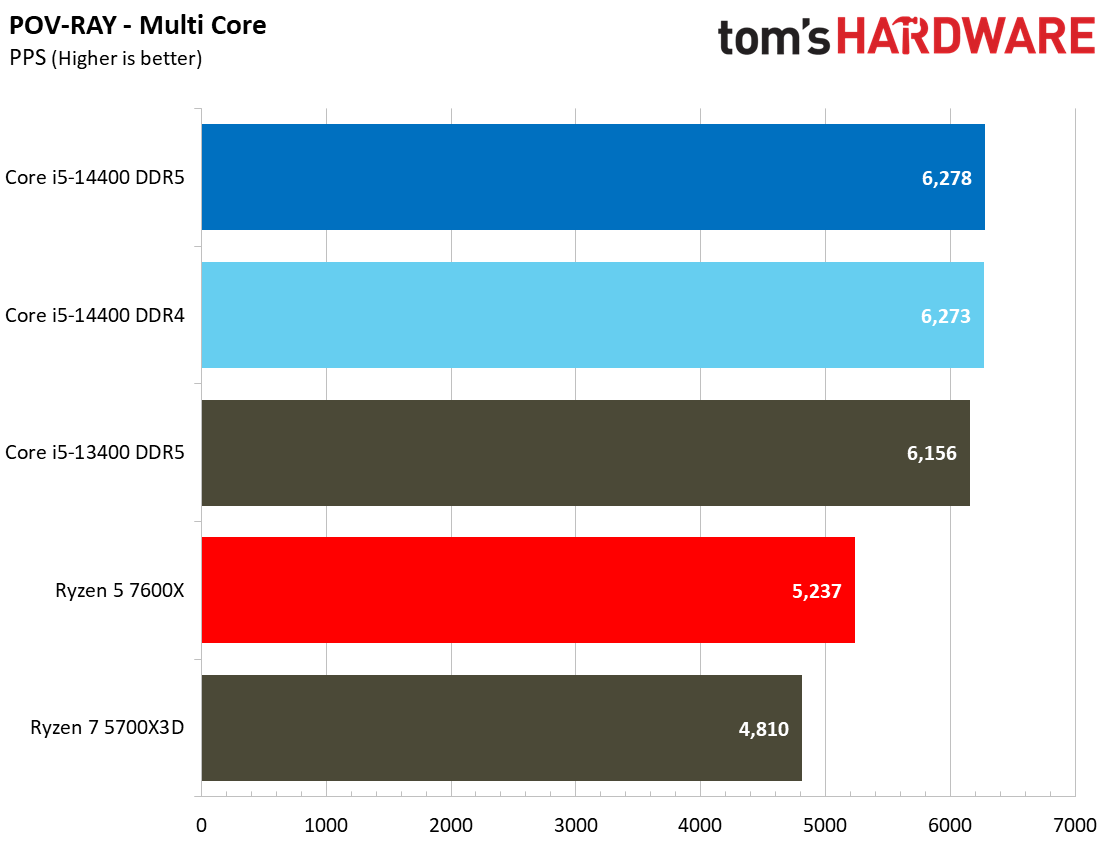











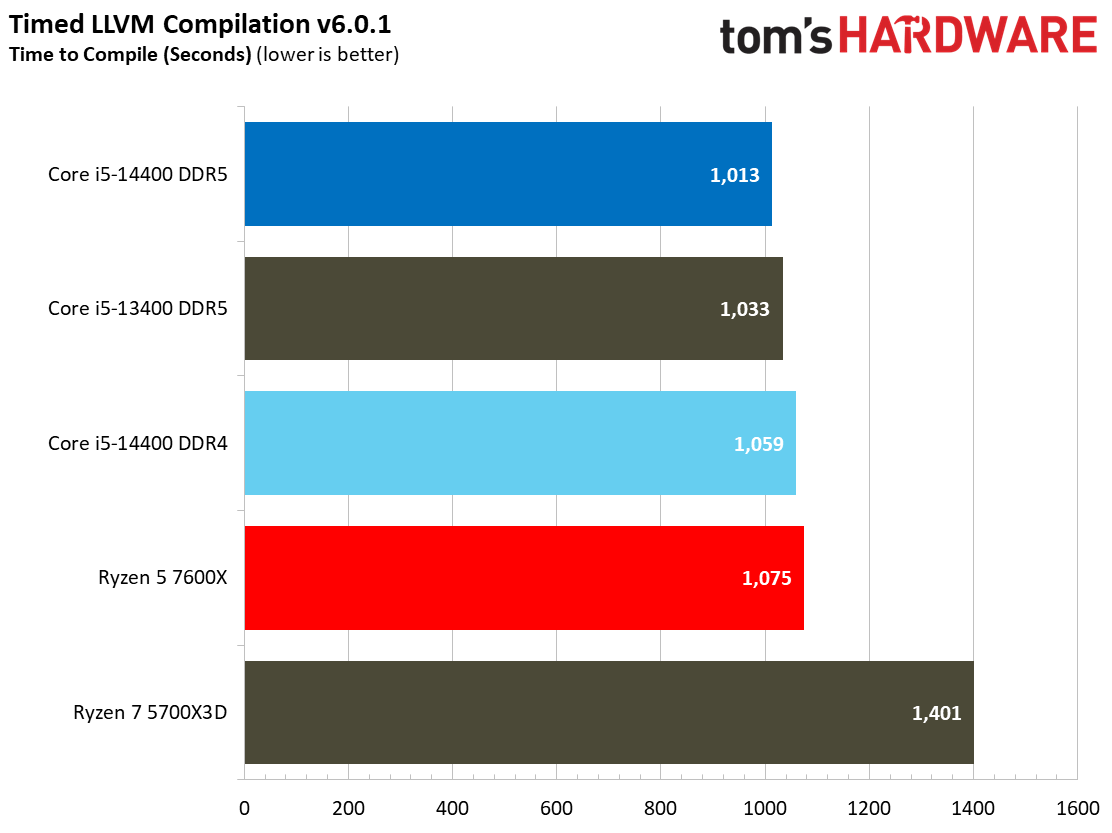

On paper, the Core i5-14400 should have the upper hand over the Ryzen 5 7600X due to its superior core count, but as we have already established, not all cores are created equal. Intel’s distribution of cores into P-Cores and E-Cores means that the number of cores does not translate linearly into performance. Performance cores are more heavily targeted during a multi-core workload, such as our productivity applications.
As you can see from our Geomean multi-threaded performance graph, the AMD Ryzen 5 7600X just about beats out the Core i5-14400 when the latter uses DDR5-6800 memory. The regular performance gap between the two CPUs using standard DDR5 memory is around 2.6%, which is outside the margin of error. Using DDR4 memory does not seem to change the results much when it comes to the Core i5-14400, as it retains roughly the same performance as the standard DDR5 configuration.
However, the AMD Ryzen 5 7600X extends its lead even more when PBO is enabled and the chip is paired with optimized DDR5-6400 memory. On average, in our productivity tests in Windows 11, the Ryzen 5 7600X with PBO enabled gained a 2.5% lead over the standard Ryzen 5 7600X and a 5.9% lead over the Core i5-14400 with the standard DDR5 configuration.
Of course, productivity performance can vary wildly depending on your particular workload. The Intel chip does lead in the Cinebench 2024 Multi-Core test simply because it has more cores to work with. The Ryzen CPU, on the other hand, leads significantly in the Y-Cruncher AVX-512 workload. It is important to research the optimization of your particular workload and see which CPU it favors more before making the purchase decision.






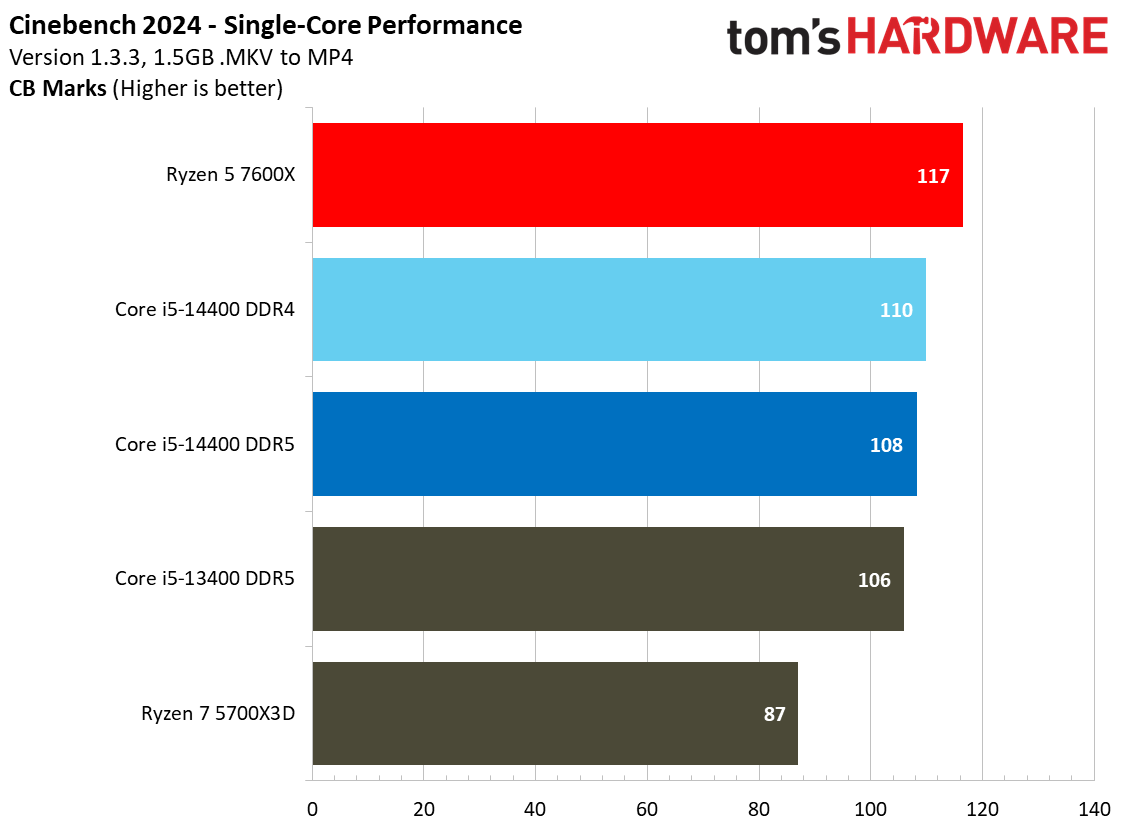


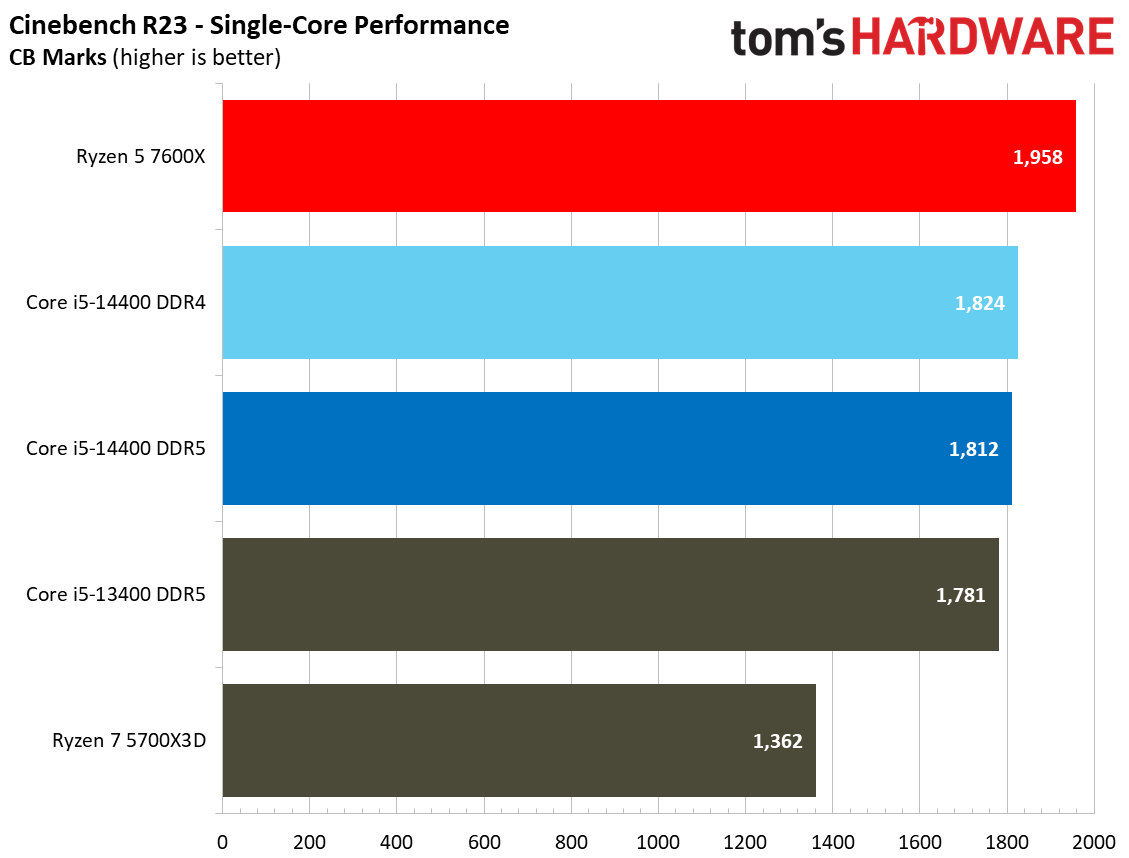
On the single-threaded side of things, the AMD Ryzen 5 7600X still holds a comfortable 6.4% lead over the Core i5-14400 in our Geomean rankings when the latter is paired with standard DDR5 memory. There is no noticeable difference between DDR4 and DDR5 memory in single-threaded performance with the Core i5-14400, nor is there any noticeable spread with optimized memory.
Turning on PBO and pairing the Ryzen 5 7600X with DDR5-6400 memory improves single-threaded performance just a bit more. This configuration is 2.53% faster than the standard Ryzen 5 7600X and 8.6% faster than the Core i5-14400 when paired with DDR5-6800 memory.
✅ Winner: AMD
Although neither of these CPUs can be considered productivity monsters, they still offer decent performance in various single-threaded and multi-threaded workloads. Depending on your productivity application of choice, you may want to tailor your purchase decision based on the optimization of that particular workload for a particular CPU.
Nevertheless, the AMD Ryzen 5 7600X comes out as the leader in most of our productivity tests. While it has fewer cores than the Intel Core i5-14400, all six can be labeled as P-Cores, but that isn't the case with the Intel chip. The Ryzen CPU leads Intel in both our single-threaded and multi-threaded Geomean rankings, and barring a few odd results here and there, it does so in most productivity applications as well.
Overclocking: Intel Core i5-14400 vs AMD Ryzen 5 7600X
Intel does not allow CPU overclocking on its non-K SKUs, which prevents us from changing the multiplier on the Core i5-14400 to increase its clock speeds. Intel also restricts CPU overclocking on its B and H-series chipsets, although memory overclocking is still possible.
On the other hand, the AMD Ryzen 5 7600X follows AMD’s tradition and has an unlocked multiplier for overclocking. Although you can try your hand at a manual all-core overclock, we would generally not recommend it for AMD chips. Instead, it would be best to opt for the Precision Boost Overdrive 2 (PBO 2) auto-overclocking feature, boosting multi-threaded performance. You can also leverage the Curve Optimization features that undervolt the cores to free up additional thermal and power headroom, thus improving the boosting behavior.
Of course, overclocking results are heavily variable and depend on your particular chip's silicon quality. Other factors are involved as well, such as the quality of your cooling solution, the power delivery of your motherboard, and the general lifespan of the silicon itself. Overclocking gains have generally been on a downward slope over the past few CPU generations for both Intel and AMD as CPU manufacturers continue to push the boost clocks as far as they safely can.
AMD allows overclocking on almost all AM5 chipsets, except A-series motherboards such as A620. Rather than going for an all-core overclock, we enabled PBO2 on our Ryzen 5 7600X sample and paired it with fast DDR5-6400 memory. In our gaming tests at 1080p, the tuned Ryzen 5 7600X showed a 7% improvement in performance over the standard Ryzen 5 7600X. The performance gain falls to 4.5% at 1440p due to the games becoming increasingly GPU-bound.
Moving onto productivity workloads, the difference shrinks quite a bit, as we can see in our graphs. The PBO-enabled Ryzen 5 7600X shows a 2.53% performance gain in single-threaded workloads and a 2.56% performance improvement in multi-threaded workloads. It is safe to say that you should not overclock the Ryzen 5 7600X if your main focus is productivity.
✅ Winner: AMD
AMD takes this round by default since the Intel Core i5-14400 is a locked chip that cannot be overclocked using traditional methods. While memory overclocking is supported on mid-range chipsets and makes a noticeable difference in most workloads, it is still not as powerful as CPU overclocking. AMD’s PBO overclocking is also super simple and can yield significant performance gains, especially in gaming.
AMD also provides unlocked multipliers on pretty much all of its consumer desktop CPUs (other than the 3D V-Cache ones), and its choice of motherboard options is also more diverse. All in all, AMD is just the undisputed winner of the overclocking round.
Power Consumption, Efficiency, and Cooling: Intel Core i5-14400 vs AMD Ryzen 5 7600X
With the introduction of Intel’s 12th-Gen Alder Lake CPUs, Intel shifted to a new “Intel 7” manufacturing process that vastly improved power consumption and efficiency across the board. The process got more refined in subsequent Raptor Lake and Raptor Lake Refresh generations, making Intel’s 14th-Gen CPUs quite respectable in terms of overall efficiency, even though they still consume a lot of power.
As a mid-range (some may even say entry-level) CPU in Intel’s lineup, the Core i5-14400 is on the lower end of the spectrum when it comes to power consumption. Moreover, Intel’s implementation of the hybrid core architecture in this CPU allows it to improve its efficiency by delegating background tasks to E-Cores, which consume only a fraction of the power compared to the regular P-Cores.
AMD’s new Ryzen 7000 series processors have taken their power consumption to a whole new level compared to previous generations. AMD has cranked the power numbers up almost all across the board to make the CPUs competitive with newer Intel competitors, and that comes at the expense of higher thermals and power draw. Although the TSMC 5nm production process is more efficient than Intel 7, the power consumption of AMD’s new processors is quite a bit more than their Ryzen 5000 series.
Still, AMD holds the advantage in performance-per-watt numbers over Intel’s Raptor Lake Refresh. Not only do the AMD CPUs consume less peak power, but they also accomplish more work per unit of power consumed, which makes them superior to the Intel competition in terms of efficiency. This is reflected in the base 105W TDP rating and 142W peak power consumption rating of the Ryzen 5 7600X as compared to the base 65W TDP rating and peak 148W MTP rating of the Core i5-14400.













Going through our power consumption test results, the Core i5-14400 and the AMD Ryzen 5 7600X start pretty equal in our multi-threaded AVX workloads, but the Ryzen 5 7600X consumes around 40% more power in our single-threaded AVX workload. The Ryzen 5 7600X starts to sip more power in our HandBrake Power test, consuming 14% more power on average than the Core i5-14400.
Our Prime95 and Blender tests show a similar trend, with the Blender Monster benchmark standing out from the rest. The Ryzen 5 7600X consumes a whopping 69.3% more power in that particular benchmark than its Intel counterpart. Our final image takes a different approach as we look at the cumulative energy required to execute an x264 and x265 HandBrake workload. In this chart, the processors that fall closer to the lower left corner are the most efficient.
We can see that although the Core i5-14400 consumes more power than its predecessor, it is still a bit more efficient than the Ryzen 5 7600X. The AMD Ryzen chip is still faster in most productivity tasks and thus takes fewer seconds to perform the test, but it generally consumes more power and expends more energy in the process.
✅ Winner: Intel
Although the Ryzen 5 7600X is quite efficient and has a very manageable power consumption, the Core i5-14400 consumes less power on average, as validated by our tests.
The AMD Ryzen 7000 series CPUs have a recognizable pattern when it comes to thermals. Regardless of the cooling element applied, the CPUs immediately climb to a temperature above 90C. This is completely within the CPUs' working limits and is expected behavior. The CPUs try to leverage all of the available power and thermal budgets to sustain their maximum performance according to the task at hand, so the Ryzen CPUs naturally tend to run hotter.
Regardless, even though the Ryzen 5 7600X is quite efficient in its own right, the Core i5-14400 takes this round due to its lower average power consumption and lower thermals.
Pricing: Intel Core i5-14400 vs AMD Ryzen 5 7600X
If we take both these CPUs at their launch and compare their MSRP pricing, it is a very competitive duel. The Ryzen 5 7600X, while offering higher performance, launched at a price of $299, which is not exactly cheap when you consider that there are no mainstream AMD Ryzen 7000 series CPUs below this price point.
On the other Intel's lineup is a bit more diverse and has more options at different price points. The Core i5-14400 has an MSRP of $225, but you can also ditch the integrated graphics and save a few bucks by going with the $210 Core i5-14400F variant. The MSRP of the standard Core i5-14400 is slightly lower than its predecessor, the Core i5-13400, which launched at $230.
Nevertheless, that comparison is no longer relevant since AMD has heavily discounted the Ryzen 5 7600X, bringing its price down to $210 at the time of writing. This changes the conversation entirely and heavily favors AMD's value proposition. The decision seems simple: buy the AMD Ryzen 5 7600X. But is it really that simple?
Here, we must consider the other expenses accompanying these CPUs. The Core i5-14400 is compatible with the LGA1700 socket and works with Intel’s 600-series and 700-series motherboards. Moreover, it supports both DDR4 and DDR5 memory, which is a big advantage over AMD in terms of setup cost. The Core i5-14400 also comes with a basic stock cooler, which, although nothing fancy, at least allows you to get up and running.
The Ryzen 5 7600X uses a brand new AMD AM5 socket and is compatible with 600-series B-series and X-series motherboards. It also has the basic A-series, but it's best to avoid that since it does not allow CPU overclocking. Unlike its Intel counterpart, the AMD Ryzen 5 7600X only supports DDR5 memory, which does increase the initial cost even though DDR5 prices have been falling gradually. The Ryzen also does not include a stock cooler, meaning you will have to invest in an aftermarket CPU cooler for this processor.
If you pick up the Core i5-14400F for $210, you can pair it with a basic B-series or H-series motherboard (since it already does not support overclocking), add some affordable DDR4 memory, and use the stock cooler to get up and running. On the contrary, you will need an aftermarket CPU cooler, a mid-range B650 motherboard (at least), and more expensive DDR5 memory to pair with your $210 Ryzen 5 7600X.
✅ Winner: AMD
Although the price cuts have definitely tipped the scales heavily in favor of the AMD Ryzen 5 7600X, it still does not run away with this round simply because its ecosystem is a bit more expensive than the Intel CPU. However, if you fully equip the Core i5-14400 with a respectable motherboard, an aftermarket CPU cooler, and DDR5 memory to unleash its full potential, its setup cost is quite comparable to the Ryzen 5 7600X.
This is why the AMD Ryzen 5 7600X convincingly wins this round, even though the Core i5-14400 can adapt to your budget range.
Bottom Line: Intel Core i5-14400 vs AMD Ryzen 5 7600X
| Row 0 - Cell 0 | Intel Core i5-14400 | AMD Ryzen 5 7600X |
| Features and Specifications | Row 1 - Cell 1 | ❌ |
| Gaming | Row 2 - Cell 1 | ❌ |
| Productivity Applications | Row 3 - Cell 1 | ❌ |
| Overclocking | Row 4 - Cell 1 | ❌ |
| Power Consumption, Efficiency, and Cooling | ❌ | Row 5 - Cell 2 |
| Pricing | Row 6 - Cell 1 | ❌ |
| Total | 1 | 5 |
Both the Intel Core i5-14400 and the AMD Ryzen 5 7600X represent the mid-range offerings from Intel and AMD’s latest generations. For AMD, the Ryzen 5 7600X's MSRP pricing is more in line with the mid-range label. The Core i5-14400, on the other hand, slots right under Intel’s main Core i5, offering a more affordable alternative for people on a modest budget.
The AMD Ryzen 5 7600X beats the Core i5-14400 almost across the board in our gaming tests at 1080p and 1440p, thanks to its improved IPC and higher boost clocks. When both CPUs are configured with standard DDR5 memory, the Ryzen chip has a 14% lead in gaming applications at 1080p. Moreover, the Ryzen 5 7600X is a more dominant productivity CPU, even though it has fewer total cores than the Core i5-14400. This leaves the Intel CPU in a precarious position, but it has some distinct advantages.
Going by MSRP pricing, the Core i5-14400 is much cheaper at $225 than the $299 for the Ryzen 5 7600X. However, recent price cuts have thrown that advantage out the window, as the AMD Ryzen 5 7600X is now available for a competitive price of $210. The Intel CPU claws back some of its value advantages by supporting more affordable DDR4 memory and cheaper entry-level motherboards, but that is not enough to justify its outright victory in this faceoff.
Intel’s chip is solid in power consumption and efficiency metrics. It consumes less average power than the Ryzen 5 7600X and displays excellent efficiency, which translates into lower thermals as well. It is also bundled with a useable stock cooler that can be helpful if you are on a tight budget. The Ryzen chip, on the other hand, tends to run a bit hotter and needs an aftermarket cooling solution to be fully functional.
The AMD Ryzen 5 7600X has another major advantage of overclocking since the Core i5-14400 has a locked multiplier and cannot be overclocked using traditional means. Turning on Precision Boost Overdrive 2 on our Ryzen 5 7600X and pairing it with fast DDR5 memory gave us a 7% gain in gaming applications at 1080p. This further increases the delta between the two CPUs in terms of performance and leaves the Intel CPU with little to cling to.
✅ Winner: AMD
Even though the Core i5-14400 offers some distinct advantages in efficiency and platform costs, it simply cannot overcome the substantial performance lead of the AMD Ryzen 5 7600X, especially after the significant price cuts. While the Core i5-14400 would have certainly been competitive with the Ryzen 5 7600X at MSRP pricing, the new $210 Ryzen 5 7600X holds a significant value advantage that blows the Core i5-14400 out of the water.
Perhaps the Core i5-14400's versatility can still make it a useful buy for budget PC builders. It can work with affordable B-series and H-series motherboards and does not need an aftermarket cooler. Perhaps more importantly, you can use your old DDR4 memory kits with this CPU without having to upgrade to a whole new platform, thus reducing your setup costs significantly.
Still, the 6-to-1 lead of the Ryzen 5 7600X in our faceoff suggests that the Core i5-14400 needs serious price cuts to remain competitive in the current market. Intel would be well-advised to place the Core i5-14600K as a direct competitor to the AMD Ryzen 5 7600X and move the Core i5-14400 further down the pricing spectrum as an entry-level alternative to older Zen 4 CPUs.
More CPU Faceoffs

Hassam Nasir is a die-hard hardware enthusiast with years of experience as a tech editor and writer, focusing on detailed CPU comparisons and general hardware news. When he’s not working, you’ll find him bending tubes for his ever-evolving custom water-loop gaming rig or benchmarking the latest CPUs and GPUs just for fun.
- Paul AlcornEditor-in-Chief
-
rluker5 14400 is a locked Alder Lake rebrand. Such cherry picking in favor of AMD.Reply
So is the faster, unlocked, currently $150 on Newegg 12600kf. Which I would think that everyone would agree, at 3/4 the price, and able to use cheaper mobos and DDR4 delivers the value beatdown on AM5's best deal. -
Roland Of Gilead Reply
Well, not really. The stock 7600x beats the 14400 with no OC in most games. So, your point is kinda moot.rluker5 said:14400 is a locked Alder Lake rebrand. Such cherry picking in favor of AMD.
What is impressive, is the 5700x3d beating both (for the most part), and from Zen3/AM4. Some legs left in the old girl yet! The 5700x3d is below 200 right now. -
rluker5 Reply
Yes, really. This is a value comparison where the faster than 14400 at stock 12600kf (and more overclockable than 7600x) is in a lower price bracket: mid $100s vs low $200.Roland Of Gilead said:Well, not really. The stock 7600x beats the 14400 with no OC in most games. So, your point is kinda moot.
What is impressive, is the 5700x3d beating both (for the most part), and from Zen3/AM4. Some legs left in the old girl yet! The 5700x3d is below 200 right now.
The 5700x3D is a better deal for games, especially as a drop in, but that wasn't the point of this article was it? It was the 7600x (on AM5) putting a beatdown on current Intel in terms of value which it utterly fails to do when you choose a better option.
The article could have been on the great deal of the 5700x3D and how the 7600x is still a terrible value compared to it and to Intel offerings for budget gamers, but it was misleading instead and tried to portray the 7600x as the best deal, which it isn't. It is just not the worst deal for budget gaming.
Edit: As a longtime 5775c owner, it is easier to see the fading of the 5700x3d. Fans of it will continue to cling to the games it does well in, but more and more games that it drops back in will continue to pop up. A CPU's speed in some games is less useful when you have already finished playing them. After the newness has worn off, doing well in the relatively few "unoptimized" ones gets to be more important, as this number will only continue to grow. And it stands out a lot when you go from 200fps in a racer or scenery viewer to not being able to hold 60fps in really congested areas where you want to see what is going on even more.
Not that it is a bad chip, and won't be good for a few more years, just that cache can only do certain things and not being able to deliver playable performance on a game you want to play outweighs epeen over oceanview framerates imo. -
jeremyj_83 Reply
12600KF is $150 and 7600X is $195 right now.rluker5 said:Yes, really. This is a value comparison where the faster than 14400 at stock 12600kf (and more overclockable than 7600x) is in a lower price bracket: mid $100s vs low $200.
Value yes but you are stuck on a dead platform and EOL RAM version. The fact that you can drop in a 9000 series and maybe a 10000 series is a bonus. Now throw on that DDR5 is going to be the RAM type going forward and overall prices will drop on that and eventually DDR4 will get more expensive.rluker5 said:cheaper mobos and DDR4 delivers the value beatdown on AM5's best deal. -
logainofhades For lower budgets, a DDR4 system can make more sense, as it gives you more money to put towards your GPU. If you can afford it, definitely go DDR5, but when every dollar counts, you want as much of your budget to go to GPU as you can, without cutting back too much, on CPU. Right now the best deal is 12600k/kf and ddr4 for such systems.Reply -
rluker5 Reply
If you are on a budget it is better to avoid frequent upgrades. Going with a new CPU after a year or two when you absolutely don't need it is not a thrifty thing to do.jeremyj_83 said:12600KF is $150 and 7600X is $195 right now.
Value yes but you are stuck on a dead platform and EOL RAM version. The fact that you can drop in a 9000 series and maybe a 10000 series is a bonus. Now throw on that DDR5 is going to be the RAM type going forward and overall prices will drop on that and eventually DDR4 will get more expensive.
Yes the 9x3d or 9950x will be much faster than the 7600x and you can save maybe half of the price over going to a similar upgrade on a completely new platform which is convenient for many, but that upgrade is close to the price as the entire platform costs of these budget builds and unless you have a top end GPU and misuse it by playing at low resolutions and settings you won't notice a difference. Which I don't like to say because I have a 13900kf and these new Arrow Lake chips are looking really shiny so I have even less justification to spend double that on a whole new platform with some 10k CUDIMMs, but it would be completely frivolous spending.
Now, if you were trying to secretly upgrade without your wife knowing you would definitely have a better chance at getting away with it on AM5. Unless she heard to open task manager or something. -
TerryLaze Reply
Yeah by the time prices drop enough for you to get a decent enough upgrade from ddr5 to ddr5 your mobo will not support the new speeds anymore.jeremyj_83 said:Now throw on that DDR5 is going to be the RAM type going forward and overall prices will drop on that and eventually DDR4 will get more expensive.
Unless you lose all of the price benefits by buying a very expensive mobo right now that will support the faster ddr5 rams at least with overclocking.
For the EOL ddr4 mobo you bought what you bought and it will last for the next 5years at least (more like 7-8) at which point you can do a full upgrade. -
jeremyj_83 Reply
The cheapest DDR5 AMD motherboard right now are the A620s with pcpartpicker having the MSI Pro A620M-E being the lowest priced. Specifications on that motherboard says it supports RAM up to DDR5-6800 including those with 24GB DIMMs for the 7000 series and DDR5-6400 24GB DIMMs for the 8000G series. All of that is listed on the QVL. As always going beyond the official support spec for RAM speed will depend more on the CPU than anything else. Your CPU needs to a RAM controller that is able to handle that speed. Not everyone will be lucky enough to have that.TerryLaze said:Yeah by the time prices drop enough for you to get a decent enough upgrade from ddr5 to ddr5 your mobo will not support the new speeds anymore.
Unless you lose all of the price benefits by buying a very expensive mobo right now that will support the faster ddr5 rams at least with overclocking.
My current desktop I got in 2013 (hoping to upgrade this year) is a Haswell 4770k on DDR3. I wish I had waited an gotten onto DDR4 instead of being on the EOL DDR3. I personally won't go with a DDR4 system now as DDR4 is being phased out. Better to be on the newer RAM IMO. Now if you have a very slim budget then I understand going on the old RAM.TerryLaze said:For the EOL ddr4 mobo you bought what you bought and it will last for the next 5years at least (more like 7-8) at which point you can do a full upgrade. -
DavidLejdar The iGPU sure is nice. Here it is running my second screen, as a sort of side-screen with e.g. movie on.Reply
One way how to approach it, sure. The benchmarks here constantly show though, that the CPU can mean quite a difference in frames per second. So myself, when I was about to upgrade from a DDR3 rig more than a year ago, I put a bit more money down for AM5, to pretty much avoid a rather expensive GPU get bottlenecked by almost everything else of the rig. Of course, if I would have went with a RX 6900 XT or so, and with DDR4 rig, I could have had a more FPS in the past year (as the better GPU would have given more in such regard). But I still had a backlog of games to play, and now with upcoming next-gen GPUs, I should be able to make full use of such, and that without need to spend still almost the same as more than a year ago on a new MB, etc.logainofhades said:For lower budgets, a DDR4 system can make more sense, as it gives you more money to put towards your GPU. If you can afford it, definitely go DDR5, but when every dollar counts, you want as much of your budget to go to GPU as you can, without cutting back too much, on CPU. Right now the best deal is 12600k/kf and ddr4 for such systems.
Comes down to personal preference, in any case though. Like, when someone plays mostly only Counter-Strike 2, casually, then even a 4GB GPU and 5+ years old CPU seems to be still good enough. -
ManDaddio AMD late to the party as usual. Some people don't want to wait 2 years for prices to drop to upgrade. I'm being a bit facetious but still.Reply
This is the same issue AMD has with GPUs.